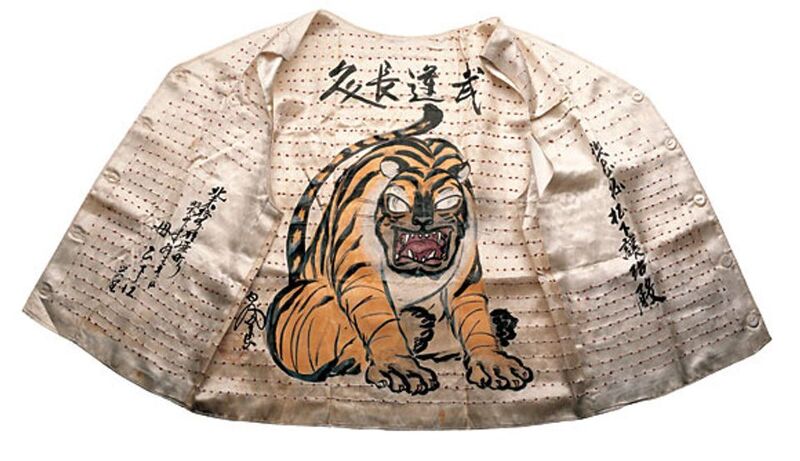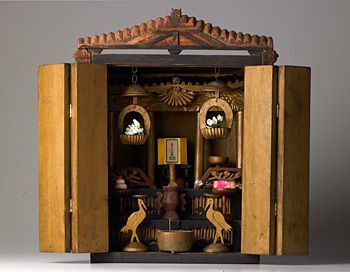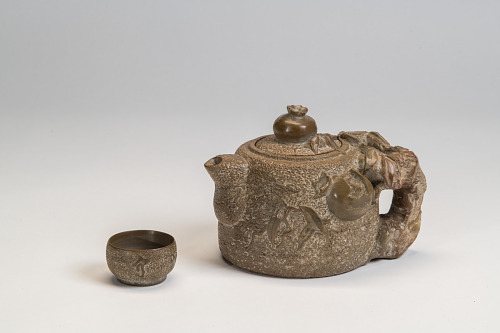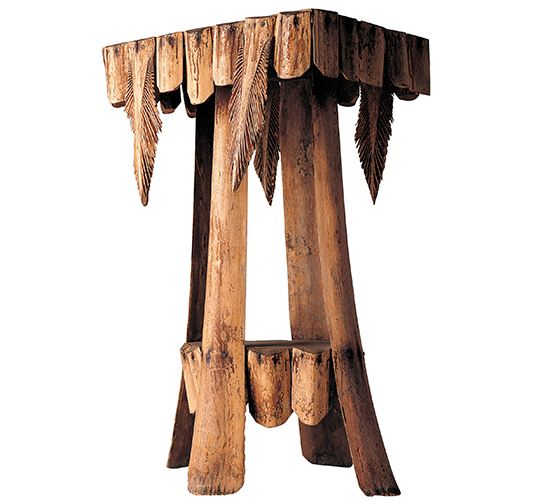Physical Works
The physical art pieces created within the aforementioned internment camps are a tangible representation of the duality of peoples’ creativity. Very human aspects of life are also displayed in this physical way. The pieces below show the influence that culture and tradition have on peoples’ inspiration for art, as seen through pieces that were sometimes practical or just reminiscent of community and traditions of past life pre-internment. Given the very serious and dark nature of internment and what circumstances these innocent civilians were facing day after day, it is very understandable that they would seek solace and routine through this mode of expression.
This senninbari vest is one example of clothing items made during internment. Unfortunately, all that is known about the artist is that she was the mother of George Matsushita, who was forced to serve for the US Army during World War II. It is also known that both he and his mother were interned at the Amache camp. His mother made this vest for him to wear while deployed, because in Japanese culture, a Senninbari vest is worn in order to protect a soldier during combat (he did wear it while fighting in Italy). Delphine Hirasuna explains that "When people went into the armed services and into harm's way—and in Japan they also made senninbari for firemen and policemen—they are being sent off with the good wishes of a thousand people." Senninbari vests are also special because they are made by tying one thousand knots by hand. Typically, it is created by each knot being tied by a different woman, but in the case of Ms. Matsushita at Amache, it was tied by different people in the camp. Besides hand making the vest itself, she also painted a tiger onto the back to symbolize courage and vitality. The Matsushita Senninbari vest at the Amache camp is but one example out of the hundreds that were being created in every single internment camp due to the volume of young men being drafted from them. The many people who joined in creating this piece as well as the massive cultural significance it holds shows how community and tradition were not lost, even within the confines of internment camps.
The floral pieces pictured above were not only beautiful pieces to look at but also served a much greater purpose. Being such dismal circumstances and being controlled by unforgiving individuals who didn’t care about allowing tradition, many camps had people who were forced to lead their own community’s wedding or funeral processions. While cemeteries existed at the camps, there were no official funerals that were held for the many who died, unless they had loved ones brave enough to host one themselves. The most common items were brooches and pins, seen here. These were created by Shigeko Shintaku (unknown), Iwa Miura (unknown), and Grace Ayako Ito (unknown) and were found to be created at the Topaz and Tule Lake camps out of scrap materials such as shells and wire. Not only can one observe the sheer artistic skill in creating such pieces, further implementation of tradition can still be seen even at different camps.
Religion and keeping faith were also common themes seen across those interned at these camps. Many either held preexisting beliefs or looked to something or someone for relief while in a cruel environment where they and their loved ones were treated horribly every day with no foreseeable end. Regardless, religious motifs are tied to many of the art pieces that came from Japanese Americans during their time in internment camps. One such piece was a butsudan created by Kichitaro Kawase while she was in the Amache camp. A butsudan is a typically small buddhist altar found in many Japanese homes. Butsudans are, in other words, akin to the house of Buddha in which he may be worshiped along with the families' ancestors. Seen above, this butsudan is extremely impressive for its intricate details and many tiers. Functional doors open to the multi-leveled home in which cranes and offerings are surrounded by beautiful, ornate designs. Similar to every art piece created within internment camps, this was made entirely out of found materials around camp. Truly a marvel of artistry, this piece shows how religion and faith can transcend strife for some.
Everyday household items were also commonly constructed, whether it be for functional use, feeling a sense of normalcy, or both. Pictured to the left is a teapot constructed out of slate at the Topaz, Utah internment camp. This teapot was decorated with sprawling vine designs, but was more than just a piece to enjoy visually. The designs themselves may be observed as Homei Iseyama (1890-1975), the artist's, past life as a gardener seeping in through its influence in her choosing leaf and pomegranate motifs. Tea was served through this pot, as the art of drinking tea is a large part of Japanese culture. There is a large emphasis placed on tea that also translated into life in the camps, seen by its necessity inspiring the creation of tea drinking tools. Additionally, the piece seen to the right is also practical yet illustrates cultural motifs. Although it is seemingly just a chair made out of palm branches and wood, the story behind it is touching. The artist, a man with the surname Tokieko, had a daughter who was very ill and needed care but was unable to while interned at the Fresno assembly center. Selflessly, their neighbors Effie and Emanuel Johnson nursed Mr. Tokieko’s daughter back to health and as a gesture of gratitude he created this table out of what he could find around the center. It is worth recognizing that although he was experiencing great horrors, the kindness shown to him was not unnoticed and in turn he created something special. This very human interaction sheds light on how people share sentimentality and communicate through creative outlets such as art.




